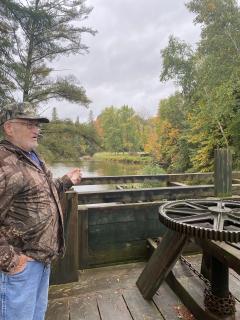Fall colors enthusiasts gather for photograph tour at Round Lake Logging Dam


WISCONSIN — Even in steady rains, nature and history enthusiasts drove to Fifield, Wisconsin, from hours away on National Public Lands Day in September. They gathered to experience northern Wisconsin fall colors at one of the most historic and scenic places in the US: Round Lake Logging Dam. Chequamegon-Nicolet National Forest volunteers and employees hosted a fall colors photography tour to interpret the dam and surrounding 3,600 acre Round Lake Recreation Area.
USDA Forest Service retiree Manny Stein highlighted points of interest and told the group about the history of the dam. He showed where the logs were placed and talked about the significance of the site. Stein co-authored a book about the dam with local resident John Berg.
During the historic logging boom, dams were opened in Wisconsin in the spring each year to help raise water levels to float logs – mostly white pine trees, known as cork pine trees because of their buoyancy – down to the Mississippi and Chippewa rivers and on to mills. There are still many white pine trees in the area that are over 140 years old.
William T. Price logging crews constructed the Round Lake Logging Dam in 1876. After official authorization in 1878, Henry Hewitt and Eric MacArthur reconstructed the dam. Historic timbers and original iron hardware were used to renovate the dam in 1995 through a cooperative partnership of local, state and federal agencies.
The Round Lake Logging Dam is possibly the only dam of its kind that remains from the logging boom of the late 19th century/early 20th century. It was included in the National Register of Historic Places in 1981.

